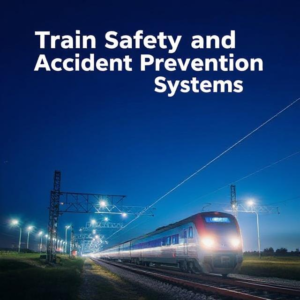Train safety and accident prevention systems are essential to ensure that trains operate smoothly and safely. These systems help reduce the chances of accidents, protect passengers, and prevent damage to the train and infrastructure. Let’s break down the key safety systems used in trains:
1. Train Signals
Train signals are like traffic lights for trains. They tell the train driver when to stop, go, or slow down. Signals are placed along the tracks and at train stations. They are usually in the form of colored lights (red, yellow, and green) or can be electronic signals.
- Red means stop.
- Yellow means slow down or caution.
- Green means it’s okay to proceed.

2. Automatic Train Protection (ATP)
ATP is a system designed to automatically stop the train if the driver doesn’t follow signals or makes a mistake. For example, if a driver ignores a red signal or is going too fast, the system will automatically apply the brakes to prevent an accident.
3. Automatic Train Control (ATC)
This system helps control the speed and movement of a train. It uses sensors to detect the speed of the train and ensures it doesn’t go beyond the safe limit. If the train is going too fast, it will automatically slow down or stop.
4. Train Collision Avoidance Systems
These systems help prevent trains from crashing into each other. They use sensors, cameras, and radar to monitor the tracks and detect any obstacles or other trains. If another train is too close, the system will warn the driver or stop the train to avoid a collision.
- Positive Train Control (PTC): A technology that helps prevent train-to-train collisions by automatically slowing or stopping a train if necessary.
5. Train Braking Systems
Brakes are vital for stopping the train safely. There are different types of braking systems, such as:
- Air Brakes: These are the most common and use air pressure to stop the train. When the driver applies the brakes, air is released, which activates the brake pads to stop the wheels.
- Dynamic Brakes: These use the train’s own motors to slow down the train.
- Emergency Brakes: These are used in case of an urgent situation, like an obstacle on the tracks or a dangerous situation. When activated, they stop the train as quickly as possible.
6. Driver Assistance Systems
These systems help train drivers by giving them important information about the train’s speed, position, and any potential risks ahead. Some systems provide warnings about approaching curves, upcoming signals, and weather conditions.
7. Track Monitoring Systems
Trains run on tracks, and those tracks need to be in good condition. Track monitoring systems use sensors and cameras to detect any damage or problems with the track. This could include things like cracks, broken rails, or obstacles. If something is wrong, maintenance workers are alerted to fix it before it causes an accident.
8. CCTV Surveillance Systems
Cameras are placed inside and outside the train to monitor activity. Inside, they help with passenger safety and security, while outside, they monitor the tracks and surroundings for any signs of danger, like animals or people on the tracks.
9. Emergency Communication Systems
These systems allow train drivers and station personnel to communicate in case of an emergency. If something goes wrong, such as an obstacle on the tracks or a signal malfunction, the driver can contact control centers to get instructions on how to proceed safely.
10. Obstacle Detection Systems
These systems are designed to detect any obstacles that may appear on the track. For example, if an animal or a person is on the tracks, the system can send an alert to the driver or even stop the train automatically.
Conclusion
All these systems work together to make sure trains are safe to ride. Signals and controls keep the train on the right path, braking systems stop the train when needed, and communication systems ensure everyone stays informed in case of an emergency. Train safety is constantly improving with newer technologies, but the goal is always the same: to prevent accidents and keep passengers safe.
Keywords: Train safety, Railway











